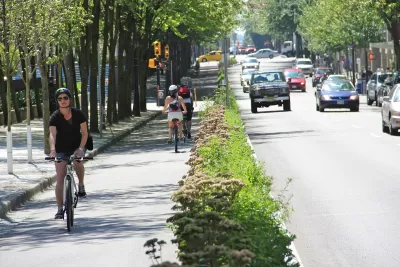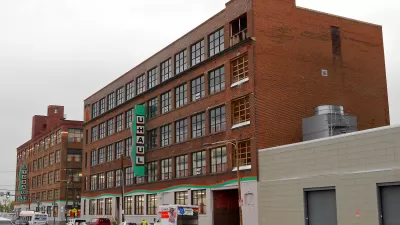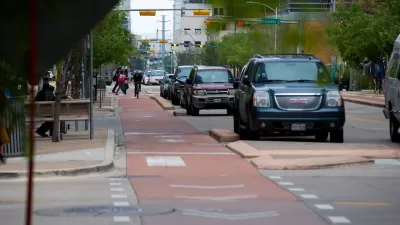Advocates in Philadelphia are pushing state lawmakers to finally pass a law to make it easier to install protected bike lanes on state routes.

Sophia Schmidt reports from Philadelphia, where a recent study into the benefits of protected bike lanes are giving local planners ammunition in their support for a proposed state law that would make it easier to build robust bike infrastructure on state routes.
“There are currently around 20 miles of protected bike lanes in the city, including parking-separated bike lanes,” according to an expert cited in the article. “But state law makes it difficult for the city to install these bike lanes on state routes that are maintained by PennDOT — which are often where they’re needed most.”
H.B. 140 would make it easier for the city to install protected bike lanes on state routes, but the bill is currently stalled in the state senate after passing the Pennsylvania House unanimously last year. The bill is also only the latest attempt, after a string of failures, to pass similar laws.
This time around, however, advocates can call on the evidence supplied by a recent report on the outcomes of a city pilot project.
In a pilot project launched in 2018, city and PennDOT officials installed parking-separated bike lanes on 10 state routes in the city, including Market Street, JFK Boulevard, Race Street in Center City, and the Chestnut Street Bridge. They’ve also evaluated case studies in peer cities, which showed parking-separated bike lanes increase perceived safety and comfort for cyclists, according to a report written by transportation consultant Kittelson & Associates, Inc.
Findings of the report include a 20 percent reduction in crashes, a 6 percent reduction of vehicle speeds, no increase in congestion, and, perhaps most strikingly, a 96 percent increase in bike trips.
FULL STORY: Philly pushes Harrisburg to pass law allowing safer bike lanes on state roads

Alabama: Trump Terminates Settlements for Black Communities Harmed By Raw Sewage
Trump deemed the landmark civil rights agreement “illegal DEI and environmental justice policy.”

Planetizen Federal Action Tracker
A weekly monitor of how Trump’s orders and actions are impacting planners and planning in America.

Why Should We Subsidize Public Transportation?
Many public transit agencies face financial stress due to rising costs, declining fare revenue, and declining subsidies. Transit advocates must provide a strong business case for increasing public transit funding.

Understanding Road Diets
An explainer from Momentum highlights the advantages of reducing vehicle lanes in favor of more bike, transit, and pedestrian infrastructure.

New California Law Regulates Warehouse Pollution
A new law tightens building and emissions regulations for large distribution warehouses to mitigate air pollution and traffic in surrounding communities.

Phoenix Announces Opening Date for Light Rail Extension
The South Central extension will connect South Phoenix to downtown and other major hubs starting on June 7.
Urban Design for Planners 1: Software Tools
This six-course series explores essential urban design concepts using open source software and equips planners with the tools they need to participate fully in the urban design process.
Planning for Universal Design
Learn the tools for implementing Universal Design in planning regulations.
Caltrans
Smith Gee Studio
Institute for Housing and Urban Development Studies (IHS)
City of Grandview
Harvard GSD Executive Education
Toledo-Lucas County Plan Commissions
Salt Lake City
NYU Wagner Graduate School of Public Service





























